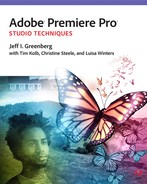Foreword
When I wrote Adobe Premiere Pro 2.0 Studio Techniques back in 2006, the landscape of nonlinear editing, not to mention the technology in the film and video business, was nothing like it is today. There were few HD video cameras, formats like DigiBeta and DVCam were still considered standard and acceptable delivery formats, and HDV was a thing. There was little discussion of 4k, and RED was the color of the Adobe logo. It’s amazing to reflect on how much has changed in the last seven years and mostly all for the better and benefit of the users and artists.
Ironically, the end of 2006 marked a major career turning point for me as I partnered with my friends Mike “Mouse” McCoy and Scott Waugh as the CTO and head of postproduction for our company, Bandito Brothers.
In a very real way, the edited component of Bandito Brothers was born and raised in Adobe Premiere Pro. The techniques I described in the previous volumes were used day in and day out as part of our post workflow. Having learned the application inside and out, we created and ran an efficient and contained postproduction pipeline that gave us complete control of all the projects we edited. We mixed and matched every format we could get our hands on, and developed a language and style that represented who we were, which now serves as the visual foundation of who we are.
While we remain deep in technology and the latest and greatest tools, Adobe Premiere Pro is still an integral part of our postproduction pipeline. With the recent Creative Cloud version of Adobe Premiere Pro, the buzz around the industry is no longer about Avid or Final Cut Pro but finally about our old friend Adobe Premiere Pro.
The principal idea of the Studio Technique series is to thrust you deeper into ideas and advanced methods of working with the tools. Lessons guide you down a path to get to a destination. But along the way you learn a bunch of tricks that make you more proficient in not only the end result, but in the details of getting there—quicker methods to complete tasks, shortcuts, workflow tips, and ways to make your content look better and your flow be more efficient.
When I wrote the previous volumes of this series, it was just me and my own collective experience. With this latest volume, readers now have the luxury of learning from a bevy of experts and professionals to create an even more dynamic and broader range of techniques that are essential to honing your skills.
At the end of the day, the tool does not make the artist. The work is made meaningful by the passion that goes into it and the content that carries it. Honing your skills and perfecting your craft enables you to get closer to creating exactly what is in your head to the best of your abilities. For me, becoming an expert in Adobe Premiere Pro was a means to fulfilling a lifelong dream of making movies, telling stories, and being a part of something I believed in. I trust that this latest volume will ensure you safe travel along your own journey and help you understand Adobe Premiere Pro in new and more powerful ways. It’s exciting when your old friend gets better with age.
—Jacob Rosenberg
Jacob Rosenberg is a Director and the CTO of Bandito Brothers in Culver City,
California. His directorial debut film, Waiting for Lightning,
was released in 2012 by Samuel Goldwyn Films.
